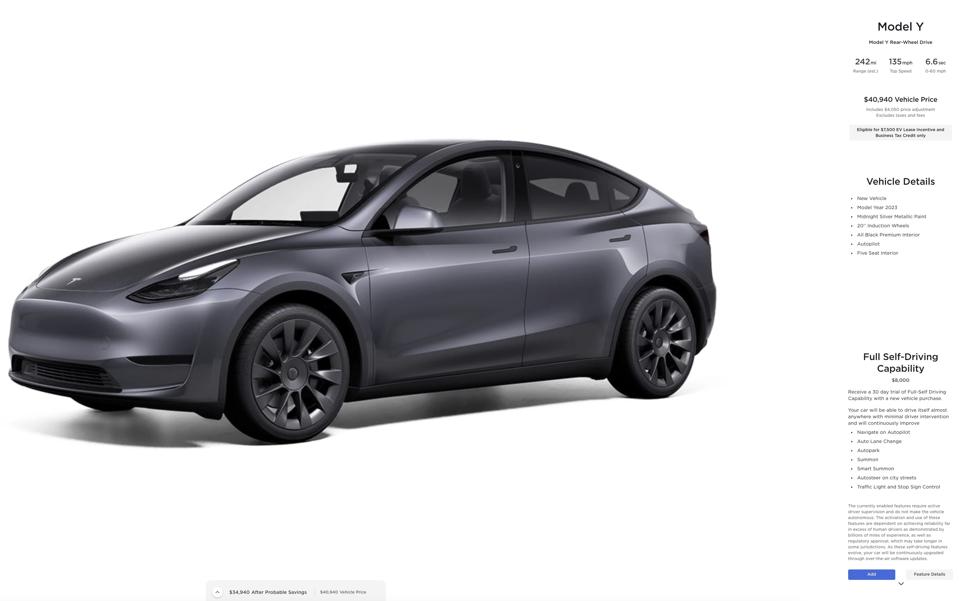Tesla has slashed prices on its best selling car in the U.S. while investors and potential future buyers wait for word on the low-cost vehicle.
The price of the Model Y was cut again — this time by $2,000, making one of the most popular EVs in the world even less expensive. On the front-door of the Tesla Model Y order page, the rear-wheel drive Model Y is listed at $42,990 and $35,490 if you include the point of sale $7,500 federal tax credit. The Model Y Long-Range Dual-Motor All-Wheel Drive is listed at $47,990 (and $40,490 with tax credit) and the Model Y Performance at $51,490 (and $43,990 with tax credit). Currently, leasing is one the least expensive ways to drive a Tesla since it offers low monthly payments and protection against price depreciation.
- A new Rear-Wheel Drive Model Y on Tesla’s inventory page with a price of $40,940 can be leased for $337 a month (as of Sunday April 21) with a $4,500 down payment and an estimated cost due at signing of $7,407, which includes upfront fees and taxes. Choose a zero downpayment and monthly payments increase to $523 and the “due at signing” payment drops to $2,625.
- Choose the popular but more pricey Long-Range Dual-Motor All-Wheel Drive priced at $47,990 model and the lease payment is $468 a month (as of Sunday April 21) with $2,999 down and an estimated $5,898 due at signing. Go with a zero downpayment and the monthly payment is $569 with $2,715 due at signing. The above pricing for both the RWD and AWD variants is for a 10,000 miles/year lease. Monthly payments will increase slightly for a 12,000 miles/year lease and more for a 15,000 miles/year lease.
- Though not necessarily important to cost-conscious buyers, Tesla has also cut the price of its Full Self-Driving option by $4,000 to $8,000 from the previous price of $12,000. The FSD subscription has also been cut to $99 a month from $199/month. With FSD, a Tesla vehicle can drive itself almost anywhere with minimal driver intervention. Most self-driving options offered today by other car manufacturers have limited use that is confined to highway driving or limited local driving.
Is the ‘Model 2’ past or prologue? Has the long-awaited Model 2 been consigned to the dustbin of history or does it represent Tesla’s future? Tesla CEO Elon Musk is expected to offer some clarification on this topic during the April 23 first quarter earnings conference call. As recently as the 2023 fourth quarter earnings conference call in January Musk talked about the “low-cost vehicle” like it was Tesla’s future, speaking at length about Tesla’s forthcoming manufacturing methodology that would reduce the cost of manufacturing a car and thus make a Model 2 possible. And he seemed to refute a Reuters story that claimed the demise of the low-cost vehicle. The car is often referred to by analysts as the Model 2 with a predicted price target of around $25,000. (More of what Musk had to say about the low-cost vehicle here.) On a positive note, the Tesla Robotaxi announcement is set for August 8 per an April 5th tweet from Musk — but that is also causing some consternation on Wall Street because Musk seems to be deemphasizing the low-cost vehicle concept.
Analyst weighs in on Model 2 — not necessarily targeted at U.S. market: “Tesla may need a product like the ‘Model 2’ in other regions much more than it needs it in the United States,” said Sam Fiorani, an analyst at AutoForecast Solutions LLC, in an email. “If Tesla wants to compete with companies like BYD, a smaller and less expensive model will be needed to increase volumes and appeal to entry-level buyers in China and possibly Europe,” Fiorani said. “Very few traditional automakers today offer North American-built, gas-powered models in the $30,000 range. Introducing an EV in that price range makes profitability very tough, if there was a significant market available,” he added.
Model 2 timing skeptic — Tesla concepts don’t arrive on schedule: “Tesla’s promise of a $25K EV always sounded a bit too good to be true, especially since we’ve never seen a Tesla product arrive on schedule or at the promised price,” Ivan Drury, Edmunds’ director of insights, told me in an email. Besides, there are other more pressing issues affecting EV demand right now — and a lower-cost vehicle may not be the solution. “Other issues beyond price are currently hindering EV sales, namely charging infrastructure and interest rates,” Drury said. “There’s no doubt we need more affordable options in both the EV and [internal combustion engine] ICE markets, but today’s market dynamics result in a scenario where a $25K hybrid vehicle would resonate more with consumers than a $25K EV,” he added.

